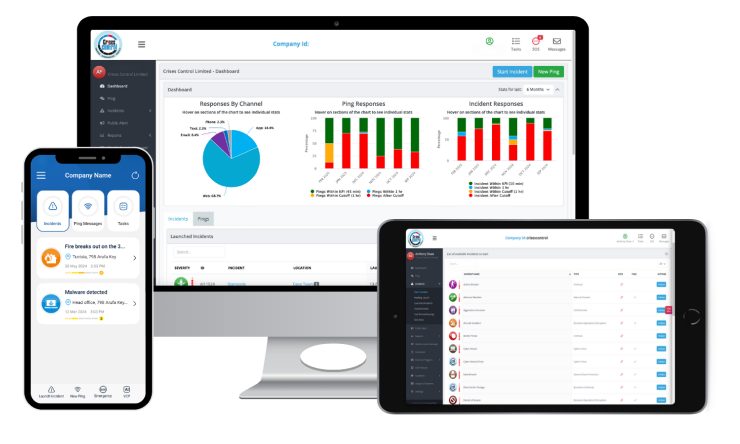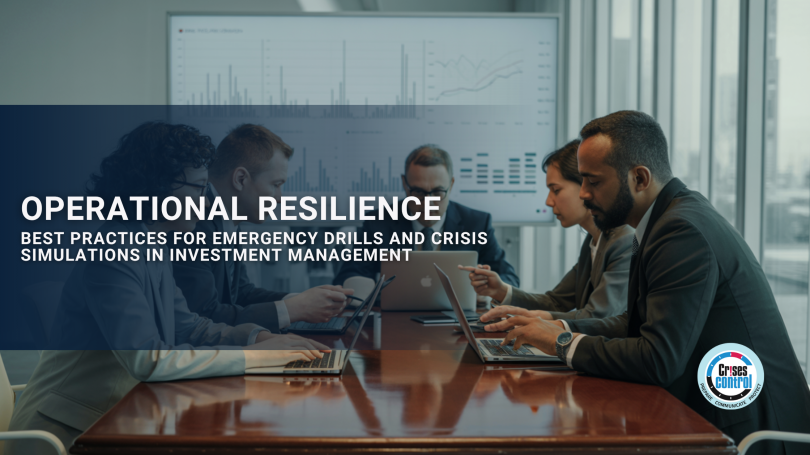Written by Anneri Fourie | Crises Control Executive
Unexpected disruptions can cause major damage to investment firms. A single system outage, cyber attack or security incident can lead to lost trades, regulatory breaches, delayed reporting and shaken investor confidence. These events don’t just disrupt operations; they put a firm’s reputation and financial stability at risk.
Many firms have a business continuity plan stored on a shelf or buried in a shared folder. But plans alone do not keep services running when something goes wrong. What matters is whether those plans work in practice. This is where operational resilience comes in. It ensures critical services continue even during disruption, not just after.
Regular emergency drills and crisis simulations give firms the chance to test their plans, train their people and expose weak spots before a real incident strikes. This article explains how investment firms can strengthen their resilience through structured testing and how Crises Control can support that process with technology designed for financial services.
Why Operational Resilience Matters in Investment Management
Investment management relies on trust, precision and speed. A cyber breach, market outage or operational failure can quickly escalate, affecting client portfolios and financial markets. Regulators in the UK, EU, US, Canada and the Middle East now require firms to prove that they can withstand and recover from severe but plausible disruptions.
Business continuity focuses on restoring services after something goes wrong. Operational resilience goes further by keeping essential functions running while a disruption is unfolding. For investment firms, this can mean keeping trading platforms online, protecting fund valuations, maintaining investor communications and meeting regulatory obligations even under pressure.
Drills and simulations bring theory to life. They help firms uncover gaps in decision-making, test escalation routes, and build confidence across teams. They turn a written plan into a real, working system.
Operational Resilience Best Practices for Investment Firms
Building strong operational resilience is not just about technology or regulation. It requires a structured, practical approach that connects strategy, people and systems. There are five key areas that investment firms should focus on.
1. Scenario Planning Based on Real Risks
A one-size-fits-all exercise is no longer enough. Regulators expect firms to test realistic and relevant scenarios. This begins with identifying the business services that are critical to your firm and mapping out what would happen if they were disrupted.
Typical scenarios include:
- A cyber attack on trading platforms or internal systems
- A major power or network outage affecting operations
- Building evacuations in key locations
- A reputational incident requiring immediate investor and regulator communication
- Geopolitical events affecting overseas teams or travel
These scenarios should reflect real vulnerabilities rather than hypothetical threats. The goal is to understand where pressure points exist and how well your current processes hold up under stress.
2. Regular and Structured Emergency Drills
Running a single drill once a year will not prepare a firm for real crises. Regular testing builds familiarity and exposes issues that might otherwise stay hidden. Quarterly or semi-annual drills involving multiple departments give a far more accurate view of readiness.
Manual notification chains often lead to confusion and delays when incidents occur. Automated systems make escalation faster and more reliable. With Crises Control, drills can be planned in advance, triggered instantly and monitored in real time, ensuring that nothing is overlooked.
3. Integrating Regulatory Compliance Requirements
Regulators are raising expectations across all major financial markets.
- In the UK, the FCA and PRA require firms to define important business services, set impact tolerances and conduct regular testing.
- In the EU, DORA mandates reporting of ICT incidents and structured scenario testing.
- In the US, the SEC is moving towards tighter reporting rules for cyber incidents.
- In Canada and the Middle East, regulators emphasise operational resilience, data protection and regular testing.
Being able to provide clear, timestamped records of drills and communications strengthens a firm’s position during audits. Crises Control offers an audit-ready platform with full reporting capabilities, helping firms meet these regulatory demands.
4. Clear Roles, Responsibilities and Communication Paths
Even the best plans fail when no one knows who should act. A common issue revealed during testing is confusion over who triggers alerts, who informs key stakeholders and who speaks to regulators or investors.
A well-structured resilience plan defines these responsibilities clearly. Crises Control allows firms to pre-assign roles and create incident workflows so that when an alert is triggered, the right people are notified immediately. This removes delays and duplication.
5. Continuous Improvement Through Review and Learning
Testing is only effective if lessons are captured and acted upon. Post-drill reviews should be mandatory, focusing on what worked, what didn’t, and what needs to change.
Crises Control provides detailed reporting, including delivery and response logs, escalation times and engagement rates. This gives resilience teams the evidence they need to make improvements and present clear results to leadership and regulators.
How to Run Emergency Drills in Financial Services
An emergency drill should feel as close to a real event as possible. This gives teams a genuine test of how well their plans work under pressure. A structured approach helps ensure consistency and clarity.
Step 1: Define the Objective
Each drill should have a clear purpose. It might be testing how quickly staff evacuate a building, how well the firm meets regulatory notification deadlines, or how communications are handled during a cyber incident. A clear objective keeps the drill focused and measurable.
Step 2: Design the Scenario
The scenario should be realistic and relevant to the firm’s critical services. Examples include testing how the trading function responds to a system outage or how investor communications are maintained during a reputational event.
Step 3: Prepare Teams and Technology
Drills can fail if basic information is out of date. Teams should verify contact lists, escalation paths and access to communication tools before the exercise. Crises Control enables firms to build incident workflows and message templates ahead of time, making activation instant.
Step 4: Execute and Monitor
The drill should be run under time pressure to create a realistic sense of urgency. Notifications should reach the right people across multiple channels such as SMS, email, app notifications and voice calls. Monitoring performance in real time helps identify delays or weak links.
Step 5: Debrief and Document
Structured debrief sessions are essential. Findings should be documented, action points assigned and improvements tracked. Crises Control’s reporting functions make it easy to capture evidence for regulatory purposes, internal reviews and board reporting.
Strengthening Regulatory Compliance with Crisis Simulations
Crisis simulations are now a regulatory expectation in financial services, not just a recommended practice. Regulators want clear evidence that firms can respond to and recover from serious events in line with legal requirements.
Crisis simulation software helps firms meet these expectations by creating a structured, repeatable process. Crises Control supports investment firms by providing:
- Automated workflows that meet escalation and reporting requirements
- Real-time alerts across multiple channels
- Comprehensive audit trails that simplify regulatory reviews
- Scheduling and tracking tools to plan regular tests
This structured approach reduces compliance risk and demonstrates to regulators and investors that the firm takes resilience seriously.
Business Continuity Planning and Operational Resilience
A business continuity plan for investment firms is only useful if it is part of a wider operational resilience strategy. Plans stored on shared drives and revisited once a year are not enough. They must be integrated with real-time communication and tested through regular drills.
A strong business continuity plan includes:
- A clear list of critical business services and tolerance thresholds
- Defined internal and external communication protocols
- Tested backup and recovery arrangements
- Integration with digital alerting platforms
- A regular testing and review cycle
Crises Control connects these elements with a single platform that activates communication and coordination at speed. When an incident happens, the plan moves from paper to action in seconds.
Why Digital Tools Strengthen Operational Resilience
Many investment firms still rely on phone trees, spreadsheets or scattered systems to respond to incidents. These methods create delays, confusion and gaps in accountability.
A digital platform brings speed, structure and visibility. It provides:
- Instant alerts to the right people
- Accurate targeting of messages
- Real-time visibility of who has responded
- Automatic logs for compliance reviews
Crises Control is built to give investment firms these capabilities in one place. It makes emergency drills easier to run, track and improve.
Building a Culture of Readiness
Technology alone cannot create resilience. People need to understand their roles, trust the communication process and practise response procedures regularly. Drills and simulations help create that culture.
They build confidence across teams and give leadership clear evidence of preparedness. Investors see a structured approach to risk, which strengthens trust. Regular testing becomes part of the firm’s rhythm, not an afterthought.
Crises Control helps make that cultural shift easier. It removes the friction of planning and running drills, so firms can focus on improving their performance rather than managing logistics.
Take the First Step Toward Stronger Operational Resilience
Operational resilience is now a regulatory requirement and a core business priority for investment firms. Regular emergency drills, structured crisis simulations and a clear business continuity plan are essential to protect clients, operations and reputation.
Crises Control provides a purpose-built platform to help firms test their plans, improve communication, and meet regulatory expectations with confidence.
To see how Crises Control can strengthen your firm’s resilience strategy, book your free demo today!
Request a FREE Demo

